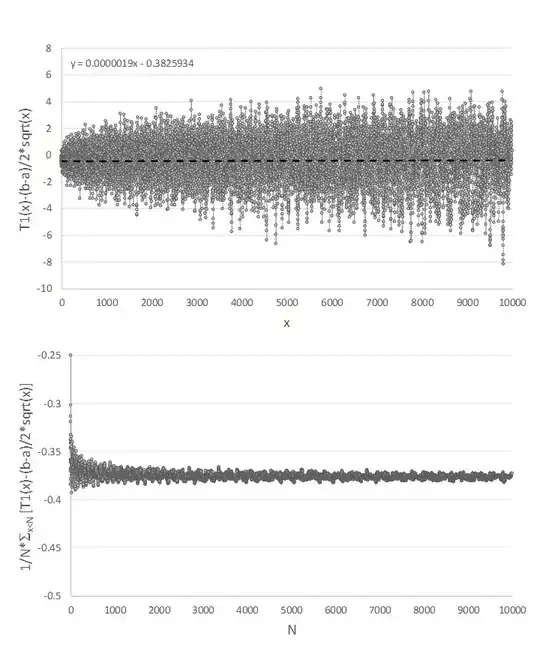We show $K_1(a,b) = -\frac{b^2-a^2}{24}-\frac{1}{2}\log(b/a)$. $K_2(a,b)$ can be found using the same methods used below.
The starting point is the identity $$\{\theta\}-\frac{1}{2} = \frac{-1}{\pi}\sum_{n=1}^\infty \frac{\sin(2\pi n\theta)}{n},$$ valid for $\theta \not \in \mathbb{Z}$ [Thanks to metamorphy for pointing out the invalidity for $\theta \in \mathbb{Z}$, and Anatoly for pointing it out again]. We show later that $$\lim_{N \to \infty} \frac{1}{N}\sum_{x=1}^N \sum_{\substack{m = a\sqrt{x} \\ m \mid x}}^{b\sqrt{x}} (\{\frac{x}{m}\}-\frac{1}{2}) = -\frac{1}{2}\log(b/a).$$
Using the fourier identity above, we obtain $$\frac{1}{N}\sum_{x=1}^N \sum_{\substack{m=a\sqrt{x} \\ m \not \mid x}}^{b\sqrt{x}} \left(\{\frac{x}{m}\}-\frac{1}{2}\right) = \frac{1}{N}\sum_{x=1}^N\sum_{m=a\sqrt{x}}^{b\sqrt{x}} \frac{-1}{\pi}\sum_{n=1}^\infty \frac{\sin(2\pi nx)}{n}.$$ For ease, we dropped the condition "$m \not \mid x$", which is allowed, since $\sin(2\pi n\frac{x}{m}) = 0$ if $m \mid x$. Since the outer two sums are finite, we may interchange to get $$\frac{-1}{\pi}\sum_{n=1}^\infty \frac{1}{n}\sum_{m=1}^{b\sqrt{N}}\frac{1}{N}\sum_{x=m^2/b^2}^{\min(m^2/a^2,N)} \sin(2\pi \frac{n}{m}x).$$ Suppose that $\frac{1}{a^2}$ and $\frac{1}{b^2}$ are integers, for ease. Using the identity $$\sin(\theta)+\dots+\sin(k\theta) = \frac{\cos(\frac{\theta}{2})-\cos((k+\frac{1}{2})\theta)}{2\sin(\frac{\theta}{2})},$$ we see that $$\sum_{x=m^2/b^2}^{m^2/a^2} \sin(2\pi\frac{n}{m}x) = \frac{1}{2\sin(\pi\frac{n}{m})}\left[\cos\left((\frac{m^2}{b^2}-1+\frac{1}{2})2\pi \frac{n}{m}\right)-\cos\left((\frac{m^2}{a^2}+\frac{1}{2})2\pi\frac{n}{m}\right)\right]$$ and $$\sum_{x=m^2/b^2}^N \sin(2\pi \frac{n}{m}x) = \frac{1}{2\sin(\pi\frac{n}{m})} \left[\cos\left((\frac{m^2}{b^2}-1+\frac{1}{2})2\pi\frac{n}{m}\right)-\cos\left((N+\frac{1}{2})2\pi\frac{n}{m}\right)\right].$$ Using again that $\frac{1}{a^2}$ and $\frac{1}{b^2}$ are integers, $$\cos\left((\frac{m^2}{b^2}-1+\frac{1}{2})2\pi \frac{n}{m}\right)-\cos\left((\frac{m^2}{a^2}+\frac{1}{2})2\pi\frac{n}{m}\right) = \cos\left(\frac{\pi n}{m}\right)-\cos\left(\frac{\pi n}{m}\right) = 0$$ and $$\cos\left((\frac{m^2}{b^2}-1+\frac{1}{2})2\pi\frac{n}{m}\right)-\cos\left((N+\frac{1}{2})2\pi\frac{n}{m}\right) = \cos\left(\frac{\pi n}{m}\right)-\cos\left(\frac{\pi n}{m}+2\pi\frac{N n}{m}\right).$$ Note that $$\cos(\frac{\pi n}{m}+2\pi\frac{N n}{m}) = \cos(\frac{\pi n}{m})\cos(2\pi\frac{N n}{m})-\sin(2\pi \frac{N n}{m})\sin(\frac{\pi n}{m}).$$ Putting everything together, $$\frac{1}{N}\sum_{x=1}^N \sum_{m=a\sqrt{x}}^{b\sqrt{x}} \left(\{\frac{x}{m}\}-\frac{1}{2}\right) = \frac{-1}{\pi}\sum_{n=1}^\infty \frac{1}{n}\frac{1}{N}\sum_{m=a\sqrt{N}}^{b\sqrt{N}} \frac{\cos(\frac{\pi n}{m})[1-\cos(2\pi \frac{N n}{m})]+\sin(\frac{\pi n}{m})\sin(2\pi \frac{N n}{m})}{2\sin(\frac{\pi n}{m})}.$$ We handle the term $$\frac{-1}{\pi}\sum_{n=1}^\infty \frac{1}{n}\frac{1}{2N}\sum_{m=a\sqrt{N}}^{b\sqrt{N}} \sin(2\pi \frac{N n}{m}) = \frac{1}{2N}\sum_{m=a\sqrt{N}}^{b\sqrt{N}} \left(\{\frac{N}{m}\}-\frac{1}{2}\right) \to 0$$ as $N \to \infty$. Now, using $1-\cos(2\theta) = 2\sin^2(\theta)$, we are left with $$\frac{1}{N}\sum_{x=1}^N \sum_{m=a\sqrt{x}}^{b\sqrt{x}} \left(\{\frac{x}{m}\}-\frac{1}{2}\right) = \frac{-1}{\pi}\sum_{n=1}^\infty \frac{1}{n}\frac{1}{N}\sum_{m=a\sqrt{N}}^{b\sqrt{N}} \frac{\sin^2(\pi \frac{N n}{m})\cos(\pi \frac{n}{m})}{\sin(\pi \frac{n}{m})}.$$ Let $$c_{n,N} = \frac{1}{N}\sum_{m=a\sqrt{N}}^{b\sqrt{N}} \frac{\sin^2(\pi\frac{Nn}{m})\cos(\frac{\pi n}{m})}{\sin(\frac{\pi n}{m})}.$$ We prove afterwards that, for any fixed $n$, $$\lim_{N \to \infty} c_{n,N} = \frac{1}{n}\frac{b^2-a^2}{4\pi}.$$ Using $$\lim_{N \to \infty} \frac{-1}{\pi}\sum_{n=1}^\infty c_{n,N} = \frac{-1}{\pi}\sum_{n=1}^\infty \lim_{N \to \infty} c_{n,N},$$ which we justify later, we finally obtain $$\frac{1}{N}\sum_{x=1}^N \sum_{\substack{m=a\sqrt{x} \\ m \not \mid x}}^{b\sqrt{x}} \left(\{\frac{x}{m}\}-\frac{1}{2}\right) = \frac{-1}{\pi}\sum_{n=1}^\infty \frac{1}{n^2}\frac{b^2-a^2}{4\pi} = -\frac{b^2-a^2}{24}.$$
We first show $$\lim_{N \to \infty} \frac{1}{N}\sum_{x=1}^N \sum_{\substack{m = a\sqrt{x} \\ m \mid x}}^{b\sqrt{x}} (\{\frac{x}{m}\}-\frac{1}{2}) = -\frac{1}{2}\log(b/a).$$ Of course, $\{\frac{x}{m}\} = 0$ if $m \mid x$. Interchanging summations, $$\frac{1}{N}\sum_{x=1}^N \sum_{\substack{m=a\sqrt{x} \\ m \mid x}}^{b\sqrt{x}} 1 = \frac{1}{N}\sum_{m=1}^{a\sqrt{N}} \sum_{\substack{m^2/b^2 \le x \le m^2/a^2 \\ m \mid x}} 1 + \frac{1}{N}\sum_{m=a\sqrt{N}}^{b\sqrt{N}} \sum_{\substack{m^2/b^2 \le x \le N \\ m \mid x}} 1.$$ $$ = \frac{1}{N}\sum_{m=1}^{a\sqrt{N}} [\frac{m}{a^2}-\frac{m}{b^2}+O(1)]+\frac{1}{N}\sum_{m=a\sqrt{N}}^{b\sqrt{N}} [\lfloor \frac{N}{m}\rfloor -\frac{m}{b^2}+O(1)] = \log(b/a)+O(\frac{1}{\sqrt{N}}).$$
We now prove that, for any fixed $n \ge 1$, $$\lim_{N \to \infty} \frac{1}{N}\sum_{m=a\sqrt{N}}^{b\sqrt{N}} \frac{\sin^2(\pi\frac{N n}{m})\cos(\frac{\pi n}{m})}{\sin(\frac{\pi n}{m})} = \frac{1}{n}\frac{b^2-a^2}{4\pi}.$$ As $\cos(\frac{\pi n}{m}) = 1+O(\frac{1}{m^2})$, and $\sin^2(\pi \frac{N n}{m}) \le 1$ and $\sin(\frac{\pi n}{m}) \gtrsim \frac{1}{m}$, we may replace $\cos(\frac{\pi n}{m})$ by $1$. Similarly, since $\sin(\frac{\pi n}{m}) \ge \frac{\pi n}{m}-c\frac{\pi^3}{n^3}{m^3}$, we may replace $\sin(\frac{\pi n}{m})$ by $\frac{\pi n}{m}$. We are left with $$\frac{1}{\pi n}\frac{1}{N}\sum_{m=a\sqrt{N}}^{b\sqrt{N}} m\sin^2\left(\pi \frac{N n}{m}\right).$$ Using again that $\sin^2(\theta) = \frac{1-\cos(2\theta)}{2}$, it suffices to show $$\frac{1}{N}\sum_{n=a\sqrt{N}}^{b\sqrt{N}} m\cos(2\pi\frac{N n}{m}) \to 0.$$ It clearly then suffices to show $$\frac{1}{N}\sum_{m=1}^{c\sqrt{N}} m\cos(2\pi \frac{N n}{m}) \to 0$$ for any fixed $c \in (0,1)$. By summation by parts, $$\frac{1}{N}\sum_{m=1}^{c\sqrt{N}} m\cos(2\pi \frac{N n}{m}) = \frac{1}{N}(c\sqrt{N})\sum_{m=1}^{c\sqrt{N}} \cos(2\pi \frac{N n}{m}) - \frac{1}{N}\int_1^{c\sqrt{N}} \left[\sum_{m \le t} \cos(2\pi \frac{N n}{m})\right]dt,$$ so it suffices to show some nontrivial amount of equidistribution of $\{\frac{N n}{m}\}$ for $m \le c\sqrt{N}$, which shouldn't be too bad.
Now we handle $K_2(a,b)$. We show that $K_2(a,b) = -\frac{b^2-a^2}{12}-\frac{1}{4}\log(b/a)$ if $\frac{1}{a^2},\frac{1}{b^2}$ are integers of the same parity. This can be extended to the case of $\frac{1}{a^2},\frac{1}{b^2}$ any integers. Take, for example, $a = \frac{1}{2}, b = 1$. For any $k \ge 1$, we have $$K_2(\frac{1}{2},1) = K_2(\frac{1}{3},1)-K_2(\frac{1}{4},\frac{1}{2})+K_2(\frac{1}{5},\frac{1}{3})-K_2(\frac{1}{6},\frac{1}{4})+\dots+K_2(\frac{1}{2k+1},\frac{1}{2k-1})-K_2(\frac{1}{2k+1},\frac{1}{2k}).$$ Since $K_2(\frac{1}{2k+1},\frac{1}{2k}) \le K_2(\frac{1}{2k+1},\frac{1}{2k-1})$ can be made arbitrarily small, we get, after a brief computation, $K_2(\frac{1}{2},1) = -\frac{1-.5^2}{12}-\frac{1}{4}\log(1/.5)$.
Similar to before, $$\frac{1}{N}\sum_{x=1}^N \sum_{\substack{m \ge a\sqrt{x} \\ 2m \mid x}}^{b\sqrt{x}} 1 = \frac{1}{N}\sum_{m=1}^{a\sqrt{N}}\sum_{\substack{m^2/b^2 \le x \le m^2/a^2 \\ 2m \mid x}} 1 + \frac{1}{N}\sum_{m=a\sqrt{N}}^{b\sqrt{N}} \sum_{\substack{m^2/b^2 \le x \le N \\ 2m \mid x}} 1$$ $$= \frac{1}{N}\sum_{m=1}^{a\sqrt{N}} \frac{m}{2}(\frac{1}{a^2}-\frac{1}{b^2})+\frac{1}{N}\sum_{m=a\sqrt{N}}^{b\sqrt{N}} \frac{N-\frac{m^2}{b^2}}{2m} = \frac{1}{2}\log(b/a)+O(\frac{1}{N}).$$ Therefore, $$\frac{1}{N}\sum_{x=1}^N \sum_{\substack{m \ge a\sqrt{x} \\ 2m \mid x}} \left(\{\frac{x}{2m}\}-\frac{1}{2}\right)$$ contributes a $\frac{-1}{4}\log(b/a)$. As before, we do $$\frac{1}{N}\sum_{x=1}^N \sum_{\substack{m \ge a\sqrt{x} \\ 2m \not \mid x}}^{b\sqrt{x}} \frac{-1}{\pi}\sum_{n=1}^\infty \frac{\sin(2\pi n \frac{x}{2m})}{n}.$$ Dropping the condition "$2m \not \mid x$" (which is permissible), interchanging sums, and using the sum-of-sines formula again, and noting that $$\cos\left((\frac{m^2}{b^2}-\frac{1}{2})\pi \frac{n}{m}\right)-\cos\left((\frac{m^2}{a^2}+\frac{1}{2})\pi\frac{n}{m}\right) = 0$$ since $\frac{1}{b^2},\frac{1}{a^2}$ are even, we obtain $$\frac{-1}{\pi}\sum_{n=1}^\infty \frac{1}{n} \frac{1}{N}\sum_{m=a\sqrt{N}}^{b\sqrt{N}} \frac{\cos(\frac{\pi n}{2m})-\cos(N \pi \frac{n}{m})\cos(\frac{\pi n}{2m})+\sin(N \pi \frac{n}{m})\sin(\frac{\pi n}{2m})}{2\sin(\frac{\pi n}{2m})}.$$ As before, $$\frac{1}{2}\frac{1}{N}\sum_{m=a\sqrt{N}}^{b\sqrt{N}} \frac{-1}{\pi}\sum_{n=1}^\infty \frac{\sin(N\pi \frac{n}{m})}{n} = \frac{1}{2}\frac{1}{N}\sum_{m=a\sqrt{N}}^{b\sqrt{N}} \left(\{\frac{N}{2m}\}-\frac{1}{2}\right) \to 0.$$ As before, we should have $$\frac{1}{N}\sum_{m=a\sqrt{N}}^{b\sqrt{N}} \frac{\cos(N\pi \frac{n}{m})\cos(\frac{\pi n}{2m})}{\sin(\frac{\pi n}{2m})} \to 0$$ as $N \to \infty$ for any fixed $n \ge 1$. And, for any fixed $n \ge 1$, as $N \to \infty$, we have $$\frac{1}{N}\sum_{m=a\sqrt{N}}^{b\sqrt{N}} \frac{\cos(\frac{\pi n}{2m})}{2\sin(\frac{\pi n}{2m})} \to \frac{1}{n}\frac{b^2-a^2}{2\pi},$$ so $$\frac{1}{N}\sum_{x=1}^N\sum_{\substack{m = a\sqrt{x} \\ 2m \not \mid x}}^{b\sqrt{x}} \left(\{\frac{x}{2m}\}-\frac{1}{2}\right) = -\frac{b^2-a^2}{12}.$$

